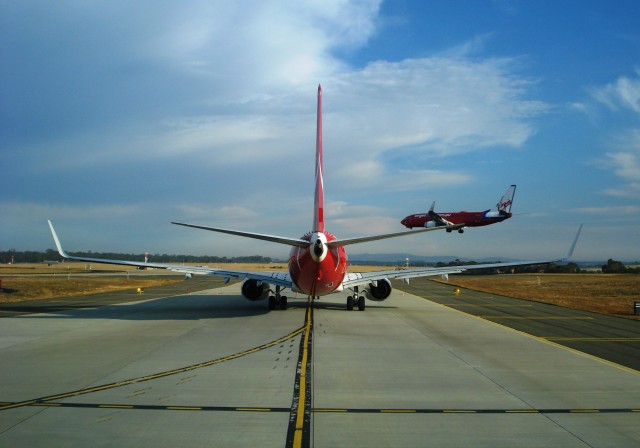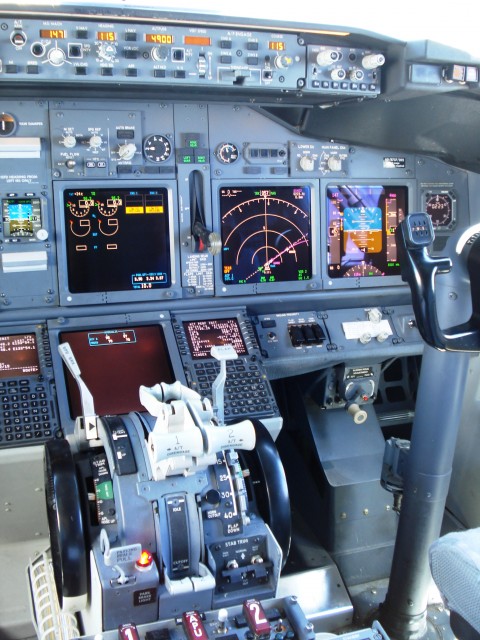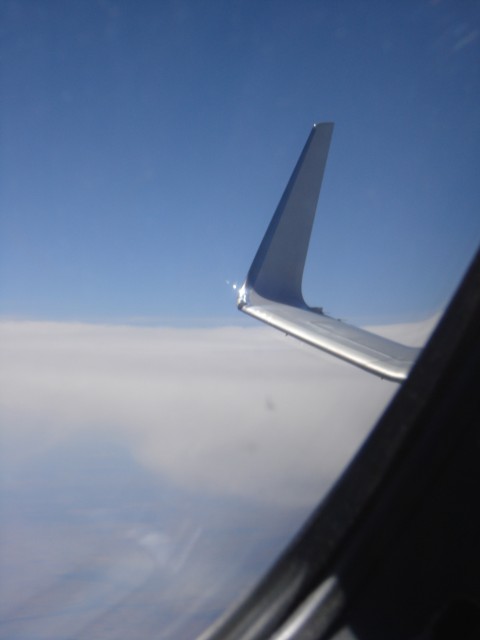Owen Zupp is a published author, journalist and experienced commercial pilot. With over 16,000 hours of varied flight experience he has flown many creatures, great and small, from outback Australia to all points across the globe. He holds a Masters Degree in Aviation Management and in 2007 his first book, Down to Earth, was published, tracing the combat experiences of a WWII RAF pilot from Dunkirk to D-Day and beyond. He also writes a blog on aviation on his website. This is a two-part story, written by Zupp, talking about his experience flying the Boeing 737 classic versus the 737 NextGeneration. Here is his story in his own words…
Introduction:
Somewhere across the globe a Boeing 737 takes off or lands every 5 seconds and over 1200 of their compatriots are aloft at any given time. With the 7000th aircraft rolled out in December 2011, the 737 has truly brought the term ’˜prolific’ to airliner production and considering the maiden flight of the 737-100 took place in 1967, it is quite appropriate that the latest metamorphism be dubbed the ’œNext Generation’.
With its title clipped to the more easily handled, ’œNG’, the ’˜next generation’ covers the -600 through to the -900 series of the 737. Of Boeing’s latest offering the 700 and larger 800s have gone on to dominate the skies, while the ’˜Max’ is still yet to come. The NGs predecessors, the -200, -300 and -400 had provided the backbone of short haul travel in a very similar way. Whilst the number of earlier models is ever dwindling, they have gone on to be referred to as ’˜The Classics’ as they reflect a last bridge between the analogue and digital flight deck. Whilst a highly visible transition, the clocks and dials are but one area of many in which the Classic has been superseded.
737 Next Generation Development:
The 737NG program was launched in 1993 under the title of 737-X. Boeing recognized the time-tested qualities of the type, but needed to bring the efficiency of new technology and systems to its most enduring machine. Fundamentally, the 737-X was to fly higher, farther, faster and more fuel efficiently than its predecessor without evolving into a new machine requiring a new designator and certification. A challenging task to say the least.
Much of the efficiency revolved around the redesigned wing. With 25% more total surface area and potentially 30% more fuel capacity, the new wing has much to offer. Boasting a higher span than the Classic, the new wing is a more swept with a constant angle of sweep and double-slotted continuous span flaps. Gone is the double swept leading edge and characteristic ’˜kink’ of the earlier wing. Similarly, there have been changes to the leading and trailing edge flaps that have resulted in weight saving as well as aerodynamic efficiency. For all of the improvements to the aerofoil and lift augmentation devices, the most visible change to the wing and the aircraft generally, is the emergence of blended winglets on the 737.
The smooth, upward sweeping fairings at the tips stand a prodigious 2.4 metres and increase the span by a metre and a half. Simply put, the winglets benefit the aircraft through the reduction of induced drag and consequently improved operational and economic performance. Whilst yielding an impressive 4% saving in mission block fuel, the winglets also increase the 800s range by over 100nm. (Source: Boeing) Improved performance out of ’˜hot, high and humid’ airfields is another advantage of the blended winglet. In fact, this aerodynamic device has proved so successful that it is now being retrofitted to 757s as well as 737s.
The NG also sees the introduction of GPS to the 737 navigation system. Previously only equipped with dual Inertial Reference Systems (IRSs), the system relied upon ’˜updates’ from ground based VORs and DMEs to continually refine the aircraft’s present position. Without such updates, the pictorial presentation on the map display could be inaccurate requiring the crew to heavily rely on ’˜raw data’ from conventional radio navigation aids. GPS provides a far more consistently accurate map display for the crew and allows for more integration of the aircraft’s Lateral Navigation (LNAV) and Vertical Navigation (VNAV) systems. Additionally, the NG is equipped with a Predictive Windshear Warning and Enhanced Ground Proximity Warning System (EGPWS). This ’˜forward-looking’ form of the original GPWS provides improved terrain clearance by such mechanisms as Terrain Clearance Floor, Look Ahead and Runway Clearance Floor algorythms.
Efficiency and costs savings can also be achieved on the ground. Production line improvements saw the final assembly of a 737NG in a record-breaking 11 days in 2005. On the maintenance side, the NG was developed with an eye to reducing airframe maintenance costs by 15%. Comprised of significantly less parts than the Classic, the NG was also designed with far more ’˜ease of access’ for maintenance crews. Redesigned leading edges, landing gear, electronics, APU and the 15% more efficient CFM56-7 engines all contributed to the bottom line. In conjunction with improved maintenance documents, corrosion prevention and extended scheduled maintenance intervals, the 737NG has won the battle of the dollar over its forerunner.
On the flight deck, the 737NG strongly resembles its twin-engined big brother, the Boeing 777. The panel is dominated by the presence of 6 LCD panels arranged side by side, replacing the combination of EFIS and analogue that was found on the Classic. For the pilots, this means a degree of modification of their instrument scan from the vertical to the horizontal. The flight deck was designed in response to the demand by operators that a new type endorsement not be needed. As a consequence, the overhead panel closely resembles the Classic with its array of toggle switches and dials, though the operation of the system behind the switch may well be different.
As for achieving higher, faster, farther and more fuel efficient performance; Boeing delivered. The NG possesses greater range by more than 400nm over the earlier model, whilst topping out at FL410 (41,000 feet) as opposed to the Classic ceiling of FL370 (37,000 feet). With a typical cruise speed of 0.78M and a sprint capability to 0.82M, the NG draws away from the Classic’s average cruise of 0.745M, whilst all the while burning less fuel. Furthermore, depending on the cabin configuration, the -800 can achieve all of this while carrying around 40 more passengers than its predecessor. From humble beginnings as the 737-100 nearly 40 years ago, the 737 has kept pace with the times through ongoing development and improvement. The 737NG is no exception.
Technologically, some 737 NGs can be equipped with a ’˜Head-Up Guidance System’ or ’˜HGS’. The HGS 4000 system features a transparent drop-down screen in front of the Captain on which is projected an array of flight information, allowing the pilot to operate in lower visibility situations than would otherwise be possible. Head-Up Display (HUD) technology has been available for years on military aircraft and Alaska Airlines started flying HUD on their 727s back in the mid-80s and all of their 737-400s are equipped with the technology.
Some airlines have opted for the Vertical Situation Display (VSD) on their aircraft. The VSD displays the current and predicted flight path of the aircraft and indicates potential conflicts with terrain. The VSD is designed to enhance situational awareness on the flight deck and is yet another way in which the Next Generation is offering advances over its predecessor.
BOEING 737 CLASSIC vs NEXT GENERATION
Part 1 | Part 2 | Owen’s Blog



WOW, the flight deck sure looks different from the classic B737s flown by Eastern Provincial Airways in the late ’60s and early ’70s!
Great article Owen! I envy those “out the cockpit window” pictures. I have a difficult time getting those as a passenger!
I think that the B737 is what Airbus hopes the A319/320/321 will eventually surpass but Boeing has done a great job of upgrading over the years. I consider the 737 a staple of commercial aircraft and laud Southwest’s business model. Its great to see these aircraft continuing on when others are seeing the sun finally set like the Mad Dogs and DC-9’s. Long live the Tin Mouse and its younger brothers!!!!!
Hi Norah, yes the 737NG is a nice bit of gear. Ours are also equipped with a Head-Up Display, or HUD.
Hi Drew, yes the flight deck is the best seat in the house, I must confess and the 737 is both a prolific and wonderful airplane; although I may be a little biased.
Thanks for the comments.
Cheers,
Owen
Nice piece! Boeing’s commitment to continuously improving this aircraft pretty much underscores its continued popularity. Earned success.. The changes have been so dramatic it’s a stark shame that the average traveler/dorky (non-aviation) reporter does not ask if it’s a Classic or Next Generation.
Hi Paulo, yes the aircraft has changed significantly over the years on a number of fronts. In the cabin, the new ‘Big Sky Interior’ has made quite a difference for the passengers with larger overhead lockers and in-seat entertainment screens throughout the airplane. It’s very impressive. Cheers, Owen.
I worked on one today — 737-700NG from PDX-SAN-PDX. It’s one of my favorites. Except for the overhead bin storage space….less per passenger than the larger 737-800NG. I remember my first trip working one…from SEA-SFO in, oh, around 1999-2000 somewhere. It’s a great aircraft. Oh, and the vacuum-flush toilets are SO much better than those blue juice ones from the past!
Amazing to think about how long the 737 has been around. Although a totally different plane nowadays, the 737 shape is still the same!
Yes, while a different airplane in many aspects, there’s no mistaking the 737. Also, the fact that they’re found in such numbers right across the globe never ceases to amaze. Cheers, Owen.
Any idea if the new MAX will still utilize the analog gauges on the overhead panel like the NG does? Just curious as to how much longer they will be needing them.
I made a reservation for me and my son to travel from Colombo to Chicago and back through Ari India. The on bound flights were as per schedule. However the return schedule (18 May) was delayed from Chicago itself and was heading for Frankfort Germany!! without heading to Delhi as scheduled. We made many complaints to your staff at Chicago airport requesting them to arrange different flights with another airline as we need to be in Colombo to start work on 21st May. After misleading us to believe that all other flights out from Chicago are full, they assured us that although we will be late for the connecting flight from Delhi to Colombo (AI 6046) they will reroute us to be in Colombo as early as possible, latest by 20 May morning.
When we landed in Delhi after about 18 hours in flight, (landed at 7.15pm on 19 May) there was absolutely no arrangements or plan to reroute us to Colombo. The staff at Delhi transfer desk was numb, and had NO idea what they should do to send us to Colombo. Later the duty officer/manager at the time total us he is doing what is necessary to send us to Colombo. Then he ended his shift at 9.30pm and vanished. The next Officer Mr. Kapil acted as if he does not hear us, and did absolutely nothing. After 4.5 hrs of shouting at Delhi transfer counter Mr.Kulwond Singh came to counter and started rerouting procedure and came up with bookings for next days” (20 May) Srilankan Airline / AI 6046 flight. Then he send us to Centaur hotel at 3.15am on 20 May, after spending 8 hrs at Delhi airport. This is atrocious service, when you consider that after a 18 flight we had to fight and argue another 8 hrs with your staff to get this kind of solution!! To start with why did they not send us to hotel as we came to transfer desk at 7.15pm?? and then do the rerouting them self??
We were given phone numbers (by Mr.Kulwond) of your duty officer/manager to obtain confirmation prior to leaving the hotel later on 20 May. With the help of Centaur hotel lobby manager we called this number (8860602150) numerous (more than 30 times) to get someone online. Finally when someone answered (Mr. A.K. Saini), he told us they are ”working on” our flight confirmations. Then around 4.30pm 20 May they called and informed us, now it”s done and we were rushed to airport by Air India staff. To our dismay we found that they are just sending us through Chennai and we would be reaching Colombo only on 21 May afternoon.
When we arrived at Chennai (20 May, 8.30pm) we were told by Air India transfer officer (Mr.Charles) who had total disregard to passenger comfort and the fact that we have already spend more than 42 hrs in airports and flights) that we just have to wait in airport (another 19 hrs) until next day. I just do not understand why Air India staff had no interest in sending us quickly to Colombo. At Chennai we notice that there are many flights (at least one flight ever two hrs) to Colombo and why they are keeping us until late next day (21 May)!!?? Finally we arrived in Colombo at 4.45pm 21 May. Which is 42 hrs later than the expected, confirmed time of arrival.
I have done more than 250 flights during my student and business career. But I have never ever felt so frustrated, humiliated and tired after this 72hrs we spend on this total flight. There are so many if”s and why not”s that we cannot answer.
Our e-ticket numbers — 0982103077355, 0982103077356.
We hold Air India totally responsible for making us feel so miserable and wasting our valuable professional time by not sending us in the quickest schedule to Colombo. We demand that you refund the full one way fares and compensate for the lost professional time of 42 hrs.
I look forward to your immediate attention and corporation.
Regards,
You’re a moron.